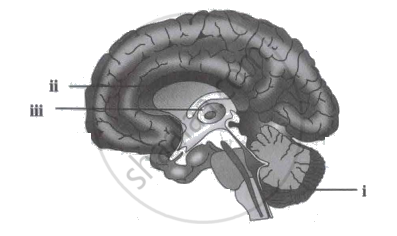Advertisements
Advertisements
प्रश्न
Explain the functions of various parts of the human brain.
उत्तर
The brain is made up of fore brain, mid brain, and hind brain.
Fore brain - It's main parts are the Cerebrum and Limbic system.
- Cerebrum - It is the largest part of the brain. It has two layers. The outer layer is grey in colour and is called the Cerebral Cortex. It regulates all the higher mental functions like attention, reasoning, learning, memory, etc. Its surface is wrinkled and divided into two symmetrical halves i.e., the right hemisphere and left hemisphere. These two hemispheres are connected by a bundle of fibres called as corpus callosum.
Left hemisphere controls language while right hemisphere controls spatial relations and pattern recognition. Each hemisphere of the cortex has four lobes i.e., frontal, parietal. temporal and occipital lobes. Two main fissures include Rolando (central) fissure (which divides frontal lobe and parietal lobe and Sylvian (lateral) fissure (separates the temporal lobe from the rest of the brain).
(a) Frontal lobe - It lies behind the forehead. It plays a role in functions like thinking, memory, reasoning, etc. The Broca's area which is responsible for speech production lies here.
(b) Parietal lobe - It lies at the top of the skull, behind the frontal lobe. It is involved in motor control and understanding information regarding the skin senses like touch, pressure, temperature, and pain.
(c) Occipital lobe - It is situated at the back of the head, behind the parietal and temporal lobes. It is the centre for visual processing i.e., to process information about colour, shape and movement of visual stimuli.
(d) Temporal lobe - It is located just above the ears. Hearing, understanding language, memory for language take place due to the temporal lobe. The Wernicke's area which is responsible for comprehension of language lies in this lobe. - Limbic System - The parts of the limbic system are:
(a) Hippocampus - It is responsible for episodic, long term memories.
(b) Amygdala - It is involved in mediating emotions, especially fear. It stores the emotional memory of our experiences.
(c) Thalamus (relay station of the brain) - It is an egg-shaped structure at the top of the brainstem. It receives all information from the sensory receptors in the body (except smell sense) and directs it to different areas of the cerebral cortex.
(d) Hypothalamus - It lies below the thalamus. Hypothalamus controls homeostatic mechanisms. It has centres for hunger, thirst, temperature regulation, sleep, etc. Hypothalamus is called the body's 'pleasure centre'. It also controls the pituitary gland.
Mid brain - It is the bridge between the hind brain and fore brain. It contains two small structures viz. superior colliculus which controls eye movements and inferior colliculus which serves as the main auditory centre for the body.
Hind brain - It's parts are Cerebellum, Brain Stem and Reticular Activation System.
- Cerebellum - It consists of two round structures. Cerebellum maintains body posture and body balance and coordinates muscle movement.
- Brain Stem - It's parts are Medulla Oblongata and Pons.
(a) Medulla oblongata - It is the lowest part of the brain stem i.e., located at the base of the skull. Medulla is called 'vital centre of the brain' as it controls vital functions like blood pressure, breathing rate, pulse rate and digestive activities. It sends sensory impulses to the brain and receives motor impulses from the brain.
(b) Pons (bridge) - It is located above the medulla. Pons serves as a bridge between the two cerebral hemispheres. It sends and receives information from the lower parts of the brain. Pons is concerned with hearing, balance. It has motor neurons which control facial movement.
APPEARS IN
संबंधित प्रश्न
The part of the brain associated with memory.
Correct the following statements by changing the underlined words:
The outermost layer of Meninges is Pia mater.
Note the relationship between the first two words and suggest the suitable word/words for the fourth place.
Cerebrum : Diencephalon :: Cerebellum : ______.
Write the function of cerebellum.
Select the odd one in the following series:
Prosencephalon, Mesencephalon, Rhombencephalon, Myelin.
Choose the correct answer.
The largest part of the brain ____________
Name the part of the human brain which is concerned with the following :
(1) Seat of memory
(2) Coordinates muscular activity.
Complete the following sentence with appropriate Word
Cerebellum is the part of the brain which is responsible for:
Which part of the brain is involved in processing the following information.
Seeing a picture
In the given diagram of the human brain identify the labels (i - iii).

Medulla oblongata controls involuntary vital activity such as ______
Vomiting is controlled by ______
The highest coordinating centre in the human body is ____________.
Forebrain is the centre of human memory.
______ is the controlling center of the body.
Midbrain contain ______
The largest basal nucleus at the floor of the cerebrum is ______.
What is the role of Broca's area?
The part of the brain concerned with body balance is ______.
Name the following:
The central space of the brain.
